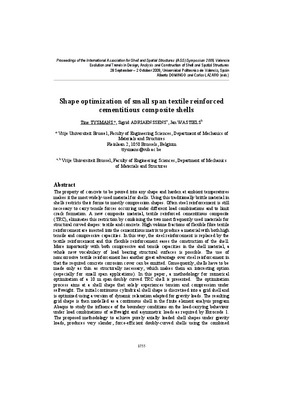JavaScript is disabled for your browser. Some features of this site may not work without it.
Buscar en RiuNet
Listar
Mi cuenta
Estadísticas
Ayuda RiuNet
Admin. UPV
Shape optimization of small span textile reinforced cementitious composite shells
Mostrar el registro sencillo del ítem
Ficheros en el ítem
| dc.contributor.author | TYSMANS, Tine
|
|
| dc.contributor.author | ADRIAENSSENS, Sigrid
|
|
| dc.contributor.author | WASTIELS, Jan
|
|
| dc.contributor.editor | Domingo Cabo, Alberto
|
es_ES |
| dc.contributor.editor | Lázaro Fernández, Carlos Manuel
|
es_ES |
| dc.date.accessioned | 2009-12-28T13:29:24Z | |
| dc.date.available | 2009-12-28T13:29:24Z | |
| dc.date.issued | 2009-12-28T13:29:24Z | |
| dc.identifier.isbn | 978-84-8363-461-5 | |
| dc.identifier.uri | http://hdl.handle.net/10251/6812 | |
| dc.description | p. 1755-1766 | en_EN |
| dc.description.abstract | The property of concrete to be poured into any shape and harden at ambient temperatures makes it the most widely-used material for shells. Using this traditionally brittle material in shells restricts their forms to mostly compression shapes. Often steel reinforcement is still necessary to carry tensile forces occurring under different load combinations and to limit crack formation. A new composite material, textile reinforced cementitious composite (TRC), eliminates this restriction by combining the two most frequently used materials for structural curved shapes: textile and concrete. High volume fractions of flexible fibre textile reinforcement are inserted into the cementitious matrix to produce a material with both high tensile and compressive capacities. In this way, the steel reinforcement is replaced by the textile reinforcement and this flexible reinforcement eases the construction of the shell. More importantly with both compressive and tensile capacities in the shell material, a whole new vocabulary of load bearing structural surfaces is possible. The use of noncorrosive textile reinforcement has another great advantage over steel reinforcement in that the required concrete corrosion cover can be omitted. Consequently, shells have to be made only as thin as structurally necessary, which makes them an interesting option (especially for small span applications). In this paper, a methodology for numerical optimization of a 10 m span doubly curved TRC shell is presented. The optimization process aims at a shell shape that solely experiences tension and compression under selfweight. The initial continuous cylindrical shell shape is discretised into a grid shell and is optimized using a version of dynamic relaxation adapted for gravity loads. The resulting grid shape is then modelled as a continuous shell in the finite element analysis program Abaqus to study the influence of the boundary conditions on the load-carrying behaviour under load combinations of selfweight and asymmetric loads as required by Eurocode 1. The proposed methodology to achieve purely axially loaded shell shapes under gravity loads, produces very slender, force-efficient doubly-curved shells using the combined tensile and compressive capacity of TRC and opens a new realm of structural curved shapes. | en_EN |
| dc.language | Inglés | en_EN |
| dc.publisher | Editorial Universitat Politècnica de València | es_ES |
| dc.relation.ispartof | Symposium of the International Association for Shell and Spatial Structures (50th. 2009. Valencia). Evolution and Trends in Design, Analysis and Construction of Shell and Spatial Structures : Proceedings | en_EN |
| dc.rights | Reserva de todos los derechos | en_EN |
| dc.subject | Textile reinforced cemtitious composite | en_EN |
| dc.subject | Shape optimization | en_EN |
| dc.subject | Small span | en_EN |
| dc.subject | Shell | en_EN |
| dc.subject | Dynamic relaxation | en_EN |
| dc.title | Shape optimization of small span textile reinforced cementitious composite shells | en_EN |
| dc.type | Comunicación en congreso | en_EN |
| dc.rights.accessRights | Abierto | es_ES |
| dc.description.bibliographicCitation | Tysmans, T.; Adriaenssens, S.; Wastiels, J. (2009). Shape optimization of small span textile reinforced cementitious composite shells. Editorial Universitat Politècnica de València. http://hdl.handle.net/10251/6812 | es_ES |
| dc.relation.conferencename | Symposium of the International Association for Shell and Spatial Structures | es_ES |
| dc.relation.conferencedate | 2009 | es_ES |
| dc.relation.conferenceplace | Valencia | es_ES |






